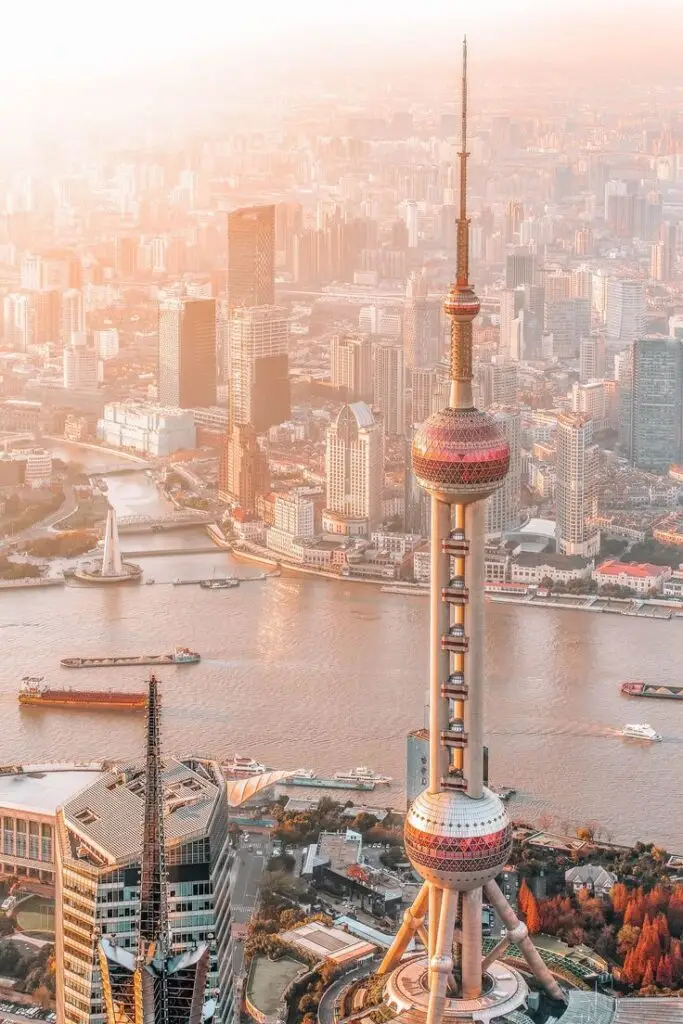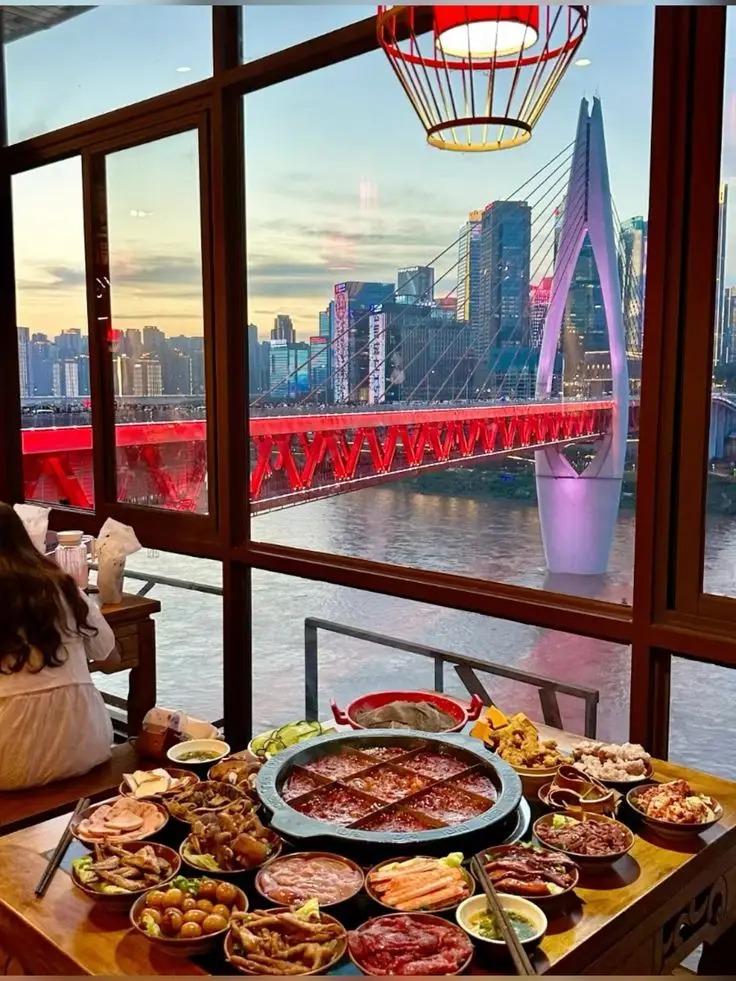Chinese architecture is a fascinating blend of rich tradition and contemporary design. You will discover how these structures embody cultural heritage while embracing modern aesthetics. This harmonious balance creates unique environments that reflect both history and innovation.
Exploring specific buildings reveals the techniques and philosophies that contribute to this architectural synthesis. By examining various examples, you can appreciate how Chinese architecture continues to evolve while maintaining its cultural significance.



1)Liuhe Pagoda (Six Harmonies Pagoda)
Liuhe Pagoda, also known as the Six Harmonies Pagoda, stands tall in Hangzhou. This pagoda was first constructed in the 10th century during the Wuyue Kingdom.
The pagoda exemplifies a harmonious blend of traditional Chinese architectural styles and modern restoration techniques. Rising 59.89 meters, it features a brick and wood structure adorned with intricate carvings and motifs.
The landmark serves both as a tourist attraction and a symbol of balance in design. From the top, you can enjoy panoramic views of the Qiantang River, showcasing the natural beauty surrounding the site.
Liuhe Pagoda reflects principles of feng shui, which emphasize harmony between nature and human-made structures. Its six levels are designed to represent stability and strength.
Visitors are often captivated by the pagoda’s elegant curves and the serene atmosphere. The combination of historical significance and scenic views makes it a noteworthy example of Chinese architecture blending tradition with modern appreciation.



2)The Great Wall of China: Mutianyu Section
The Mutianyu section of the Great Wall offers a stunning representation of both historical significance and modern preservation efforts. This part of the Wall, built during the Ming Dynasty, is known for its beautiful scenery and unique architecture.
You can explore watchtowers that provide panoramic views of the surrounding mountains and verdant forests. The restoration of this section has maintained its original charm while ensuring visitor safety.
Walking along the Mutianyu section, you will notice the blend of traditional building techniques with contemporary amenities such as cable cars. This balance makes it accessible while respecting its historical context.
The wall here features diverse elements, from granite pavements to intricately designed battlements. Each construction choice reflects the careful planning and craftsmanship of its makers.
Visiting Mutianyu allows you to appreciate the Wall’s grandeur without the massive crowds found in other areas. It serves as an inviting entry point for anyone wanting to engage with China’s architectural heritage.



3)Jin Mao Tower
The Jin Mao Tower, located in Shanghai, stands at 421 meters tall. Completed in 1999, it was the tallest building in China at the time.
The design reflects a blend of traditional Chinese architectural elements with modern skyscraper aesthetics. Its unique tiered form is inspired by ancient pagodas.
You will notice the building’s façade, made of glass and steel, representing modernity. The Chinese cultural influence is evident in its symbolism; for instance, the number eight holds significance in Chinese culture, representing prosperity.
Inside, the Jin Mao Tower integrates sustainable practices, showcasing a commitment to eco-friendly design. You can find observation decks offering panoramic views of the city.
The tower is also home to a luxury hotel and offices, embodying a harmonious balance of function and form. This structure is a significant landmark, symbolizing Shanghai’s rapid urban growth and cultural revival.


4) Shanghai World Financial Center
The Shanghai World Financial Center stands as a symbol of China’s rapid modernization. Completed in 2008, it rises to a height of 492 meters, making it one of the tallest buildings in the world.
Designed by Kohn Pedersen Fox, its unique form resembles a bottle opener. This design reflects both modern architectural innovation and traditional Chinese values of functionality.
The building features a mix of glass and steel, allowing for stunning views of Shanghai’s skyline. Its observatory on the 100th floor offers a panoramic perspective of the city, bridging the past and the future.
You can also see how it integrates with the surrounding environment. The landscaping at its base includes water features and green spaces, emphasizing harmony with nature.
The Shanghai World Financial Center exemplifies how contemporary architecture can embrace cultural elements while pushing design boundaries. It highlights a balanced coexistence of tradition and modernity in one of the world’s most dynamic cities.


5) Suzhou Museum by I.M. Pei
Suzhou Museum, designed by I.M. Pei, exemplifies a seamless integration of traditional Chinese elements and modern architectural principles. Opened in 2006, it offers a fresh perspective on the relationship between nature, culture, and design.
Pei’s design includes geometric forms and a minimalist aesthetic, while also paying homage to classical Suzhou gardens. The use of water features and open spaces creates a serene environment, enhancing your experience as you explore the museum.
The building materials further reflect a balance between tradition and innovation. White walls and gray roofs evoke traditional Suzhou architecture, while large glass panels invite natural light, emphasizing transparency and connection to the surrounding environment.
As you walk through, you’ll notice the thoughtful arrangement of exhibition spaces that respects historical artifacts while providing modern functionality. This dialogue between the past and present makes Suzhou Museum a pivotal example of contemporary architecture rooted in tradition.


Historical Context
Understanding the historical backdrop of Chinese architecture reveals the principles that underpin its designs. Key influences stem from ancient architectural practices and the evolution of styles through various dynasties.
Ancient Architectural Principles
The foundations of Chinese architecture rest on principles established thousands of years ago. Emphasis is placed on harmony with nature, balance, and the significance of orientation. Structures were often aligned with the cardinal directions, with the primary building facing south to capture sunlight.
Materials such as wood and earth were favored for their availability and local relevance. The intricate use of brackets and beams allowed for expansive roofs that protected against the elements. Color symbolism also played a vital role; red, for instance, represented happiness and prosperity. These principles have influenced modern architecture’s attempt to merge tradition with contemporary aesthetics.
Evolution Over Dynasties
Chinese architecture has continuously transformed through dynastic changes. Each dynasty introduced distinctive designs, responding to political, cultural, and environmental factors.
The Han Dynasty saw the introduction of sophisticated earthen structures, while the Tang Dynasty celebrated openness and the use of vibrant colors. The Song Dynasty shifted focus toward smaller, more intimate spaces, reflecting social changes.
The Ming and Qing Dynasties perfected courtyards and upward-reaching eaves, emphasizing grandeur and stability. This historic layering makes the transition to modern designs more seamless, as contemporary buildings often echo these past styles while integrating advanced materials and technologies.
Modern Influences
Modern Chinese architecture showcases a remarkable integration of new materials and adaptive design approaches suited for contemporary urban landscapes. These elements not only enhance functionality but also respect and reflect cultural heritage.
Integration of New Materials
You will notice the use of advanced materials such as glass, steel, and reinforced concrete in modern Chinese architecture. These materials allow for innovative designs that were not possible with traditional methods.
For example, the use of glass facades creates a sense of lightness and transparency, fostering a connection between indoor and outdoor spaces. This design choice also enhances energy efficiency through natural lighting.
Additionally, steel structures provide flexibility and strength, enabling architects to explore bold forms and expansive spaces. This integration of new materials while maintaining traditional aesthetics exemplifies a harmonious balance between the old and the new.
Adaptation to Urban Environments
In a rapidly urbanizing China, many architectural projects adapt to dense cityscapes. These designs often incorporate multi-purpose spaces that cater to diverse community needs.
You can find buildings with green roofs, vertical gardens, and sustainable technologies. These features not only contribute to environmental sustainability but also enhance the urban experience.
Moreover, modern designs often reflect the local context, ensuring that new constructions resonate with the surrounding environment. This approach fosters a sense of identity while accommodating the growing population and urban complexities.
Sustainable Practices
Many modern Chinese buildings incorporate sustainable practices, blending traditional techniques with contemporary needs. Both eco-friendly building methods and energy-efficient design play crucial roles in creating structures that are mindful of environmental impact.
Eco-Friendly Building Techniques
Traditional Chinese architectural methods emphasize materials that are sustainable and locally sourced. For example, many buildings utilize bamboo, which is known for its rapid growth and strength.
Also, rammed earth construction is regaining popularity. This technique uses earth as a primary building material, providing natural insulation and durability.
Using reclaimed wood is another method. It reduces waste and tells a story of the past, connecting the building to its environment. These approaches not only preserve resources but also offer aesthetic elements that resonate with nature.
Energy Efficiency in Modern Designs
Modern Chinese architecture increasingly focuses on energy efficiency to reduce carbon footprints. Solar panels are a common feature, harnessing sunlight to power buildings sustainably.
Designs often incorporate large windows to maximize natural light. This reduces the need for artificial lighting, contributing to energy conservation.
Additionally, green roofs and vertical gardens enhance insulation and improve air quality. These features create a comfortable climate inside while promoting biodiversity outside.
Innovative heating and cooling systems, such as geothermal technology, also enhance energy efficiency, making buildings not just modern but environmentally sound.






